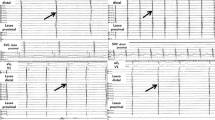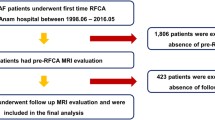Abstract
Background
The reduction in the left atrial appendage (LAA) flow velocity is related to the presence of emboli in atrial fibrillation (AF) patients. The LAA is located on the left superior side of the left atrial (LA) anterior wall, and we investigated the relationship between the reduction in the LAA flow velocity (LAAFV) and low voltage zones (LVZs < 0.5 mV) on the LA anterior wall.
Methods
In 146 persistent AF patients, LAAFV measurements, by transesophageal echocardiography, and catheter ablation were performed. LA mapping was performed before ablation during sinus rhythm, and the locations of any anterior-LVZs were documented.
Results
Eighty-one patients had a documented LVZ on the LA anterior wall, and those with an LVZ had a significantly lower LAAFV compared to those without (anterior-LVZ(+) vs. anterior-LVZ(−) = 26 ± 11 vs. 34 ± 10 cm/s, p < 0.001), while no significant difference was observed when compared to the other LVZ regions. A low-LAAFV (≦ 20 cm/s) was observed in 36 patients, and the CHADS2-vasc score and existence of an anterior-LVZ were associated with a low-LAAFV. In patients with anterior-LVZs, the distance between the anterior-LVZ and LAA orifice correlated with a low LAAFV (r = 0.534, p < 0.001) as compared to the surface area of the anterior-LVZ (r = − 0.288, p = 0.009).
Conclusions
In persistent AF patients, an LVZ on the LA anterior wall was associated with a low LAAFV. In addition, an anterior-LVZ located near the LAA orifice was further related to a reduction in the LAAFV.



Similar content being viewed by others
References
Fatkin D, Kelly RP, Feneley MP. Relations between left atrial appendage blood flow velocity, spontaneous echocardiographic contrast and thromboembolic risk in vivo. J Am Coll Cardiol. 1994;23:961–9.
Yaghi S, Song C, Gray WA, Furie KL, Elkind MS, Kamel H. Left atrial appendage function and stroke risk. Stroke. 2015;46:3554–9.
Zabalgoitia M, Halperin JL, Pearce LA, Blackshear JL, Asinger RW, Hart RG. Transesophageal echocardiographic correlates of clinical risk of thromboembolism in nonvalvular atrial fibrillation. Stroke Prevention in Atrial Fibrillation III Investigators. J Am Coll Cardiol. 1998;31:1622–6.
Matsumoto Y, Morino Y, Kumagai A, Hozawa M, Nakamura M, Terayama Y, et al. Characteristics of anatomy and function of the left atrial appendage and their relationships in patients with Cardioembolic stroke: a 3-dimensional transesophageal echocardiography study. J Stroke Cerebrovasc Dis. 2017;26(3):470–9.
Daccarett M, Badger TJ, Akoum N, Burgon NS, Mahnkopf C, Vergara G, et al. Association of left atrial fibrosis detected by delayed-enhancement magnetic resonance imaging and the risk of stroke in patients with atrial fibrillation. J Am Coll Cardiol. 2011;57(7):831–8.
Allessie M, Ausma J, Schotten U. Electrical, contractile and structural remodeling during atrial fibrillation. Cardiovasc Res. 2002;54:230–46.
van Brakel TJ, van der Krieken T, Westra SW, van der Laak JA, Smeets JL, van Swieten HA. Fibrosis and electrophysiological characteristics of the atrial appendage in patients with atrial fibrillation and structural heart disease. J Interv Card Electrophysiol. 2013;38(2):85–93.
Hensey M, O'Neill L, Mahon C, Keane S, Fabre A, Keane DA. Review of the anatomical and histological attributes of the left atrial appendage with descriptive pathological examination of morphology and histology. J Atr Fibrillation. 2018;10(6):1650.
Jadidi AS, Cochet H, Shah AJ, Kim SJ, Duncan E, Miyazaki S, et al. Inverse relationship between fractionated electrograms and atrial fibrosis in persistent atrial fibrillation: combined magnetic resonance imaging and high-density mapping. J Am Coll Cardiol. 2013;62:802–12.
Ling Z, McManigle J, Zipunnikov V, Pashakhanloo F, Khurram IM, Zimmerman SL, et al. The association of left atrial low-voltage regions on electroanatomic mapping with low attenuation regions on cardiac computed tomography perfusion imaging in patients with atrial fibrillation. Heart Rhythm. 2015;12:857–64.
Nakahara S, Yamaguchi T, Hori Y, Anjo N, Hayashi A, Kobayashi S, et al. Spatial relation between left atrial anatomical contact areas and circular activation in persistent atrial fibrillation. J Cardiovasc Electrophysiol. 2016;27:515–23.
Yang G, Yang B, Wei Y, Zhang F, Ju W, Chen H, et al. Catheter ablation of nonparoxysmal atrial fibrillation using Electrophysiologically guided substrate modification during sinus rhythm after pulmonary vein isolation. Circ Arrhythm Electrophysiol. 2016;9:e003382.
Hori Y, Nakahara S, Kamijima T, Tsukada N, Hayashi A, Kobayashi S, et al. Influence of left atrium anatomical contact area in persistent atrial fibrillation-relationship between low-voltage area and fractionated electrogram. Circ J. 2014;78:1851–7.
Kusa S, Komatsu Y, Taniguchi H, Uchiyama T, Takagi T, Nakamura H, et al. Left atrial appendage flow velocity after successful ablation of persistent atrial fibrillation: clinical perspective from transesophageal echocardiographic assessment during sinus rhythm. Am Heart J. 2015;169(2):211–21.
Nagashima K, Okumura Y, Watanabe I, Nakai T, Ohkubo K, Kofune M, et al. Does location of epicardial adipose tissue correspond to endocardial high dominant frequency or complex fractionated atrial electrogram sites during atrial fibrillation? Circ Arrhythm Electrophysiol. 2012;5(4):676–83.
Lee JM, Seo J, Uhm JS, Kim YJ, Lee HJ, Kim JY, et al. Why is left atrial appendage morphology related to strokes? An analysis of the flow velocity and orifice size of the left atrial appendage. J Cardiovasc Electrophysiol. 2015;26(9):922–7.
Jeong WK, Choi JH, Son JP, Lee S, Lee MJ, Choe YH, et al. Volume and morphology of left atrial appendage as determinants of stroke subtype in patients with atrial fibrillation. Heart Rhythm. 2016;13(4):820–7.
Akoum N, Fernandez G, Wilson B, Mcgann C, Kholmovski E, Marrouche N. Association of atrial fibrosis quantified using LGE-MRI with atrial appendage thrombus and spontaneous contrast on transesophageal echocardiography in patients with atrial fibrillation. J Cardiovasc Electrophysiol. 2013;24:1104–9.
Müller P, Makimoto H, Dietrich JW, Fochler F, Nentwich K, Krug J, et al. Association of left atrial low-voltage area and thromboembolic risk in patients with atrial fibrillation. Europace. 2018;20(FI_3):f359–65.
Park JH, Joung B, Son NH, Shim JM, Lee MH, Hwang C, et al. The electroanatomical remodelling of the left atrium is related to CHADS2/CHA2DS2VASc score and events of stroke in patients with atrial fibrillation. Europace. 2011;13(11):1541–9.
Venteclef N, Guglielmi V, Balse E, Gaborit B, Cotillard A, Atassi F, et al. Human epicardial adipose tissue induces fibrosis of the atrial myocardium through the secretion of adipofibrokines. Eur Heart J. 2015;36:795–805a.
Haemers P, Hamdi H, Guedj K, Suffee N, Farahmand P, Popovic N, et al. Atrial fibrillation is associated with the fibrotic remodeling of adipose tissue in the subepicardium of human and sheep atria. Eur Heart J. 2017;38:53–61.
Lavie CJ, Pandey A, Lau DH, Alpert MA, Sanders P. Obesity and atrial fibrillation prevalence, pathogenesis, and prognosis: Effects of Weight Loss and Exercise. J Am Coll Cardiol. 2017;70(16):2022–35.
Willens HJ, Gómez-Marín O, Nelson K, DeNicco A, Moscucci M. Correlation of CHADS2 and CHA2DS2-VASc scores with transesophageal echocardiography risk factors for thromboembolism in a multiethnic United States population with nonvalvular atrial fibrillation. J Am Soc Echocardiogr. 2013;26(2):175–84.
Zuo K, Sun L, Yang X, Lyu X, Li K. Correlation between cardiac rhythm, left atrial appendage flow velocity, and CHA2 DS2 -VASc score: study based on transesophageal echocardiography and 2-dimensional speckle tracking. Clin Cardiol. 2017;40(2):120–5.
Pak HN, Oh YS, Lim HE, Kim YH, Hwang C. Comparison of voltage map-guided left atrial anterior wall ablation versus left lateral mitral isthmus ablation in patients with persistent atrial fibrillation. Heart Rhythm. 2011;8:199–206.
Yoshida K, Ulfarsson M, Oral H, Crawford T, Good E, Jongnarangsin K, et al. Left atrial pressure and dominant frequency of atrial fibrillation in humans. Heart Rhythm. 2011;8:181–7.
De Jong AM, Maass AH, Oberdorf-Maass SU, De Boer RA, Van Gilst WH, Van Gelder IC. Cyclical stretch induces structural changes in atrial myocytes. J Cell Mol Med. 2013;17:743–53.
Anjo N, Nakahara S, Okumura Y, Hori Y, Nagashima K, Komatsu T, et al. Impact of catheter tip-tissue contact on three-dimensional left atrial geometries: relationship between the external structures and anatomic distortion of 3D fast anatomical mapping and high contact force guided images. Int J Cardiol. 2016;222:202–8.
Vatan MB, Yılmaz S, Ağaç MT, Çakar MA, Erkan H, Aksoy M, et al. Relationship between CHA2DS2-VASc score and atrial electromechanical function in patients with paroxysmal atrial fibrillation: a pilot study. J Cardiol. 2015;66(5):382–7.
Ochiumi Y, Kagawa E, Kato M, Sasaki S, Nakano Y, Itakura K, et al. Usefulness of brain natriuretic peptide for predicting left atrial appendage thrombus in patients with unanticoagulated nonvalvular persistent atrial fibrillation. J Arrhythm. 2015;31(5):307–12.
Author information
Authors and Affiliations
Corresponding author
Ethics declarations
Conflict of interest
The authors declare that they have no conflict of interest.
Ethical approval
All patients underwent an electrophysiological study and catheter ablation under the approval of the institutional committee on human research at our institution.
Additional information
Publisher’s note
Springer Nature remains neutral with regard to jurisdictional claims in published maps and institutional affiliations.
Rights and permissions
About this article
Cite this article
Hori, Y., Nakahara, S., Nishiyama, N. et al. Impact of low-voltage zones on the left atrial anterior wall on the reduction in the left atrial appendage flow velocity in persistent atrial fibrillation patients. J Interv Card Electrophysiol 56, 299–306 (2019). https://doi.org/10.1007/s10840-019-00532-z
Received:
Accepted:
Published:
Issue Date:
DOI: https://doi.org/10.1007/s10840-019-00532-z




